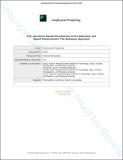| dc.description.abstract | Microseismic monitoring has proven to be an invaluable tool for optimizing hydraulic fracturing stimulations and monitoring reservoir changes. The signal to noise ratio (SNR) of the recorded microseismic data varies enormously from one dataset to another, and it can often be very low especially for surface monitoring scenarios. Moreover, the data are often contaminated by correlated noises such as borehole waves in the downhole monitoring case. These issues pose a significant challenge for microseismic event detection. On the other hand, in the downhole monitoring scenario, the location of microseismic events relies on the accurate polarization analysis of the often weak P-wave to determine the event azimuth. Therefore, enhancing the microseismic signal, especially the low SNR P-wave data, has become an important task. In this study, a statistical approach based on the binary hypothesis test is developed to detect the weak events embedded in high noise. The method constructs a vector space, known as the signal subspace, from previously detected events to represent similar, yet significantly variable microseismic signals from specific source regions. Empirical procedures are presented for building the signal subspace from clusters of events. The distribution of the detection statistics is analyzed to determine the parameters of the subspace detector including the signal subspace dimension and detection threshold. The effect of correlated noise is corrected in the statistical analysis. The subspace design and detection approach is illustrated on a dual-array hydrofracture monitoring dataset. The comparison between the subspace approach, array correlation method, and array short-time average/long-time average (STA/ LTA) detector is performed on the data from the far monitoring well. It is shown that, at the same expected false alarm rate, the subspace detector gives fewer false alarms than the array STA/LTA detector and more event detections than the array correlation detector. The additionally detected events from the subspace detector are further validated using the data from the nearby monitoring well. The comparison demonstrates the potential benefit of using the subspace approach to improve the microseismic viewing distance. Following event detection, a novel method based on subspace projection is proposed to enhance weak microseismic signals. Examples on field data are presented indicating the effectiveness of this subspace-projection-based signal enhancement procedure. | en_US |
